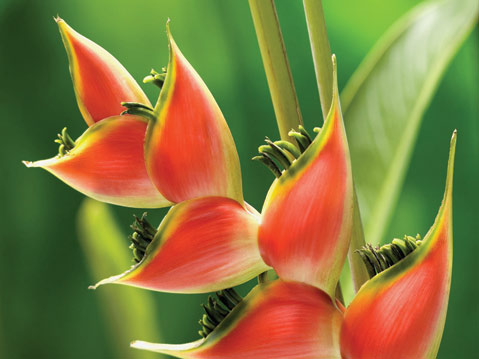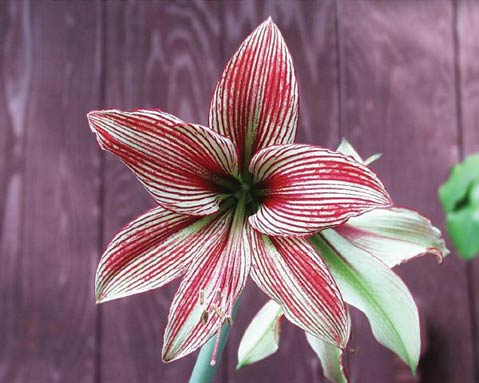Show-Off Flowers
Outsized, Fragrant, and Colorful Blossoms Make Their Seasonal Appearance

Flowers come in all sizes, shapes, and colors for lots of evolutionary reasons, but most of them center on sex; a plant’s need to spread pollen to ovary to make seed for the next generation. Sometimes it is fragrance to attract a specific pollinating bird or insect that takes precedence. Other times, it will be pigmentation to reflect just the right range of light to guide the insect to visit. Just plain gaudiness can also help increase the chances that a particular plant will attract enough pollination attention. Sometimes big is better. Amaryllis or, more correctly, Hippeastrum caught the eye of humans as well as bugs.

The species are native to Central and South America and have been hybridized extensively to play up their natural good looks. Sturdy stems, topped with several large trumpet-shaped flowers, grow out of a hefty deciduous bulb. Each plant will produce one or two stems and each stem will support an average of three flowers that flare to four or five inches in diameter and nearly as deep. Red is a dominant color in many of the selections, but elaborate striping and startling color combinations also top the list of reasons to grow these beauties. In mild climes, they can be grown outdoors and will eventually multiply to create gorgeous spring displays. They also take well to containers and can be rotated into the spotlight when they strut their stuff. Even that special hostess gift that was forced into bloom at a particular holiday time will adjust to a more normal schedule in a year or two.
Blood lily (Scadoxus multiflorus var. katherinae) dispenses with petals, but the explosion of numerous flowers sporting brilliant red stamens is showy enough without them. The spherical blooms can be softball-sized and reminiscent of fireworks, with the widely radiating flowers forming a globe-shaped compound inflorescence. Although in the same family as amaryllis, blood lily is native to South Africa. It, too, is bulbous, but in Southern California new sprouts often push their way up through the flagging foliage from last year. In regions where frosts occur, it will happily grow in a pot. Unlike some bulbs that like to be crowded, blood lily requires a couple of inches between it and the pot wall. In pots, the bulbs should be allowed to dry out after blooming for a dormant period. Keep cool but not cold, and water again next season.
Things tend to get big in the tropics, and the flower spikes of many heliconias are stunning examples from tropical America. Heliconia is related to ginger and banana but has, by far, the showiest inflorescences of that group. Sometimes called lobster claw, the actual flowers are enclosed in brightly colored bracts. These structures may be somewhat boat-shaped or beaky, similar to those of bird-of-paradise, but they are strung along a fibrous stem that may be several feet long. Some species hold these stems upright while others dangle them like elaborate jewelry. Few can be grown outdoors where temperatures dip below 50 degrees Fahrenheit at night; those that do will attract immediate attention. Since most are quite large, they don’t take to indoor culture well, but if large tubs can be managed, the diversity expands. Heliconia latispatha, H. schiedeana, and H. farinosa are good candidates.
There are plenty of natural giants such as the giant onion (Allium giganteum) and giant calico flower (Aristolochia gigantea). Plant hybridizers have been able to coax gigantism out of many flowers, too. Sunflowers are larger than they would have been naturally, for example. One last natural beauty is the lotus (Nelumbo nucifera). Both in Asia and North America, where the two subspecies of this ancient plant grow naturally, populations of plants display hundreds or thousands of flowers that can be six to 10 inches in diameter. Individual petals may be nearly teacup-sized and, when they fall from the ephemeral flowers, which only last three days or so, float away like fairy boats. The flowers aren’t the whole story; this aquatic giant sends prickly stems a couple of feet above the pond surface to spin catering platter-sized leaves, conjuring a circus juggler’s act as background to the stupendous flowers.
Large isn’t for every garden, but it is fun to imagine a place for these outsized blossoms to make their seasonal appearance amid the more modest garden varieties for a stunning surprise.
May Tips
• Look for any standing water around the garden that could be possible breeding places for mosquitoes.
• Now that the soil is warming up, plant tropical and subtropical varieties such as avocado, bougainvillea, and palms.
• Wash off aphids, but leave a few so that beneficial insects will have a reason to come to your aid.
• Plant peppers, tomatoes (watch out for hornworms), and eggplant as well as beans, cucumbers, and squash.



